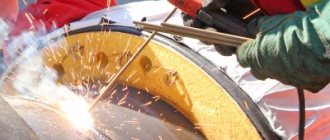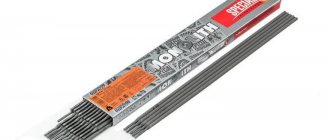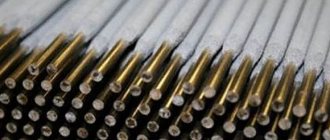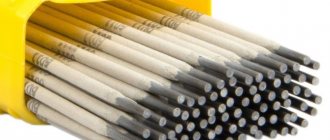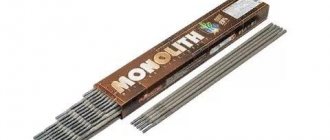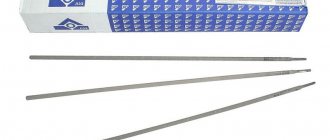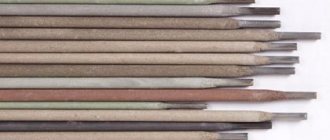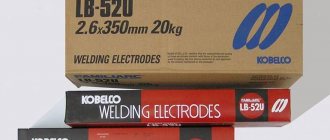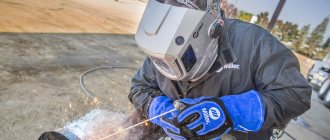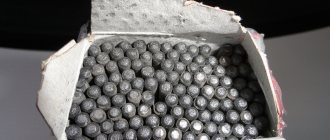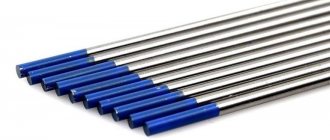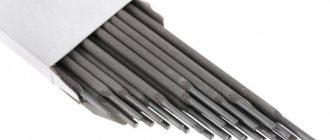Storage rules
Have you ever used a welding machine?
It happened! It didn’t happen
The main problem encountered during storage is high air humidity. The electrode coating quickly absorbs moisture, making it impossible to work with such filler material. The only way to correct the situation is to calcinate the welding electrodes.
For this, there are special ovens or portable canisters with heating elements. At home, it is recommended to store packages open (without polyethylene) at a temperature of 20-22 degrees, relative humidity 40-50%.
Wet electrodes can cause pores to appear on the surface and inside the seam, and an increase in metal spattering will also be observed.
To correctly select welding electrodes, you need to have a good understanding of what alloy you need to work with.
You should also carefully prepare the additive itself and the surfaces to be welded for the operation:
- Remove dirt and rust.
- Heat the electrodes.
- Set the welding current correctly.
If the technology is followed, you can count on obtaining seams with the characteristics specified by the electrode manufacturer.
- What gasoline should I use for my chainsaw? How to breed?
- How to choose a generator for your dacha. Main criteria and review of the best models
- Pumping station for a summer residence. How to choose? Model overview
Melting electrodes.
Consumable electrodes are the welding material most commonly used in home welding. The main components of such an electrode are a rod and a coating.
The consumable electrode rod is made of steel wire, for the production of which low-carbon or alloy steel is used. In general, there are currently 77 grades of steel wire that are used in the production of consumable electrodes and on which the grade of electrodes for welding depends - the diameter of this wire can vary from 1.6 to 6 mm.
The coating of welding electrodes performs a variety of functions at once. And one of the main actions that the coating performs is to protect the metal from the adverse effects of the surrounding air. In addition, coating the electrode helps remove harmful substances from the metal itself. And of course, the coating helps to stabilize the burning of the welding arc as much as possible.
As for the composition of the electrode coating, it contains several elements:
- slag-forming substances - manganese ore, chalk, marble, feldspar, kaolin. These substances help protect the workpiece material from the effects of oxygen and nitrogen contained in the air.
- deoxidizing substances – ferroalloys based on manganese, aluminum, titanium, silicon. The purpose of these substances is to remove oxygen contained in the molten metal of the workpiece
- gas-forming substances – dextrin, wood flour. These substances, when burned, form a gas coating around the workpiece, which does not allow harmful environmental substances to penetrate the molten metal.
- alloying substances – chromium, nickel, manganese, molybdenum, titanium, vanadium. Such additives are necessary to ensure that the weld receives the characteristics necessary for further operation - strength, resistance to high and low temperatures, mechanical damage and corrosion.
- stabilizing substances - potassium, calcium, sodium. They are necessary to stabilize the welding arc
- binders - as a rule, this is a silicate glue that forms the coating, binding its various components to each other, and in addition, serves to form the entire electrode, tying the coating to the rod.
Consumable electrodes used for welding are divided into different types, according to their markings located on the surface of each electrode.
Whether an electrode belongs to a particular brand depends on the characteristic it exhibits during the welding process. So, electrodes are classified
- depending on the material they are intended for welding - cast iron, steel or non-ferrous metals
- depending on the specific process they are intended for - for welding with deep penetration of metal or for welding seams located in a certain position in space
- depending on what type of coating was used in their manufacture - acid coating, rutile coating, basic coating
- by coating thickness – thin coating, medium, thick, extra thick
- by coating composition and rod composition
- according to the current used to work with them - direct or alternating with direct or reverse polarity
- by the quality of workmanship, as well as by the quality of the coating and the amount of harmful substances contained in it (sulfur or phosphorus).
And each of the above characteristics of electrodes has its own letter or numerical designation, which is reflected in the marking written on the electrode. For example, the letter Y indicates that the electrode is intended for welding steel, the letter C indicates that the electrode has a medium coating, and the letter P indicates that the electrode has a rutile coating. The number 1, which is the penultimate number in the marking, indicates that this electrode is used in any spatial position of the seam, and the last number 0 makes it clear that the electrode is suitable for DC welding.
Properties of electrode coating components
In order for the seam to come out of good quality, special components are needed. So, when performing welding work, in the welding zone it is necessary to ensure the creation of the most suitable conditions for quick and reliable connection of metal surfaces. Let us list the main tasks performed by electrodes with special coating.
Arc discharge stabilization
In order for the welded arc to have maximum stability, the electrodes are coated with special substances that have a low ionization potential. This leads to the fact that when performing welding work, the arc is saturated with free ions, which stabilize the combustion process. Today, electrode coating may include components such as potash, sodium or potassium liquid glass, chalk, titanium concentrate, barium carbonate, etc. These coatings are called ionizing.
Protecting the welding area from atmospheric gases
The components that make up the electrode coating contribute to the creation of a protective cloud consisting of carbon dioxide and carbon monoxide, and also participate in the formation of the slag layer that forms on the weld and shelters the weld pool from gases contained in the surrounding air. Gas-forming components include dextrin, cellulose, starch, food flour and others. And slag is formed by kaolin, marble, chalk, quartz sand, titanium concentrate, etc.
Electrode coating components and their properties
In addition to protecting the weld from gases contained in the air, slag helps to reduce the cooling rate of the metal and its subsequent crystallization, which in turn has a beneficial effect on the release of gases and unnecessary impurities from the metal being welded.
Weld metal alloying
Alloying helps to improve a number of properties of the weld. The main metals that contribute to alloying are titanium, manganese, silicon and chromium.
Melt deoxidation
During welding, it is very important to remove oxygen from the metal, for which special deoxidizers are used - these are substances that react with oxygen more efficiently than iron and bind it. These are titanium, molybdenum, aluminum or chromium added as ferroalloys to the electrode coating composition
Tying all the constituent elements together
Coated electrodes require a strong connection between the coating and the rod, as well as all the constituent elements of the coating among themselves. In this case, the main binding component is sodium silicate or liquid potassium glass. It is worth recalling that liquid glass (essentially silicate glue) also perfectly stabilizes the welding arc, which makes it an indispensable component of all types of electrodes.
Electrode symbols
The symbol for electrodes for electric arc welding and surfacing of steels contains information on the brand and type of electrode, rod diameter and standard number. The symbol for electrodes for welding structural and heat-resistant steels also contains information on the type of coating. For example, the symbol for electrodes ANO-7 E50A-5.0-F GOST 9467-60 contains the following information:
- ANO-7 – designation of the electrode brand;
- E50A – designation of the electrode type (E – electrodes for arc welding, 50 – temporary minimum guaranteed resistance of the weld material in kgf/mm2, A – guarantee of obtaining increased ductile properties of the weld metal);
- 5.0 – cross-section of the electrode rod in mm;
- F – calcium fluoride coating;
- GOST 9467-60 – standard for these electrodes.
Classification of coated steel electrodes for manual arc welding
Classification of coated electrodes, depending on their purpose
Electrodes for manual arc welding are manufactured in accordance with the requirements of GOST 9466. Depending on the area of application, according to GOST 9467, coated steel electrodes for arc welding are divided into the following groups:
U - for welding carbon and low-carbon structural steels with a temporary tensile strength of 600 MPa. For this purpose, according to GOST 9476, the following brands of electrodes are used: E38, E42, E42A, E46, E50, E50A, E55, E60.
L - electrodes of this group are used for welding alloy steels, as well as for welding structural steels with a tensile strength of more than 600 MPa. These are brands of electrodes such as E70, E85, E100, E125, E150.
T - these electrodes are intended for welding alloyed heat-resistant steels. B - electrodes for welding high-alloy steels with special properties (GOST 10052). N - electrodes for surfacing surface layers with special properties.
Classification of electrodes, depending on the type of coating
A - electrodes with an acidic coating (for example, ANO-2, SM-5, etc.). These coatings consist of oxides of iron, manganese, silica, and ferromanganese. These electrodes are highly toxic due to the manganese oxide content, but at the same time they are highly manufacturable.
B - main coating (electrodes UONI-13/45, UP-1/45, OZS-2, DSK-50, etc.). These coatings do not contain iron or manganese oxides. The composition of the coating for UONI-13/45 electrodes includes marble, fluorspar, quartz sand, ferrosilicon, ferromanganese, ferrotitanium, mixed with liquid glass. When welding with electrodes with a basic coating, a weld with high ductility is obtained. These electrodes are used for welding critical welded structures.
R - electrodes with rutile coating (ANO-3, ANO-4, OES-3, OZS-4, OZS-6, MR-3, MR-4, etc.). The basis of the coating of these electrodes is rutile TiO2, which gives the name to this group of electrodes. Rutile electrodes for manual arc welding are less harmful to health than others. When welding metal with such electrodes, the thickness of the slag on the weld is small and the liquid slag quickly hardens. This allows these electrodes to be used to make seams in any position.
Ts - group of electrodes with cellulose coating (VSC-1, VSC-2, OZTS-1, etc.). The components for such coatings are cellulose, organic resin, talc, ferroalloys and some other components. Electrodes with this coating can be used for welding in any position. They are mainly used when welding thin metals. Their disadvantage is the reduced ductility of the weld.
Classification of electrodes by coating thickness
Depending on the thickness of the coating (the ratio of the diameter of the electrode D to the diameter of the electrode rod d), electrodes are divided into groups:
M - with a thin coating (D/d ratio no more than 1.2). C - with medium coverage (D/d ratio ranging from 1.2 to 1.45). D - with a thick coating (D/d ratio ranging from 1.45 to 1.8). D - electrodes with particularly thick coating (D/d ratio more than 1.8).
Classification of electrodes by quality
Classification by quality includes taking into account such indicators as manufacturing accuracy, the absence of defects in the weld made by the electrode, the condition of the surface of the coating, the sulfur and phosphorus content in the weld metal. Depending on these indicators, electrodes are divided into groups 1,2,3. The larger the group number, the better the quality of the electrode and the higher the welding quality.
Classification of electrodes by spatial position during welding
There are 4 groups of electrodes, depending on the permissible spatial arrangement of the parts being welded:
1 - welding is allowed in any position; 2 - welding in any position, except for making vertical seams from top to bottom; 3 - welding in the lower position, as well as making horizontal seams and vertical seams from bottom to top; 4 - welding in the lower position and lower “in a boat”.
In addition to the above classification methods, GOST 9466 provides for the classification of electrodes depending on the polarity of the welding current, open circuit voltage, and type of power source of the welding arc. Based on these indicators, the electrodes are divided into ten groups and are designated by numbers from 0 to 9.
Classification of coated welding electrodes
A large number of brands of coated welding electrodes are produced in production, intended for different types of materials to be welded, all spatial positions, type and polarity of current, etc. For a more convenient choice of electrode and understanding of the differences, the following classification of coated electrodes is introduced.
Figure 1. Classification of coated electrodes
According to their intended purpose, welding electrodes for manual welding are divided into:
U - for welding structural carbon and low-alloy steels with tensile strength up to 60 kgf/mm2; L - for welding structural alloy steels with a tensile strength of more than 60 kgf/mm2; N - for surfacing a layer with special properties; T - for welding heat-resistant steels; B - for welding high-alloy, acid-resistant, heat-resistant and others with special properties;
Electrodes are divided according to the type to which they belong. Electrodes are also distinguished by brand. Several or one brand may correspond to one type. For more details, see the Electrode Catalog
Depending on the thickness of the coating, electrodes are divided into: M - electrodes with a thin coating; C - with medium coverage; D - with thick electrode coating; G - with a particularly thick coating.
Electrodes are divided according to the requirements for the accuracy of their manufacture, the condition of the coating surface, the continuity of the weld made by these electrodes, and the content of sulfur and phosphorus in the deposited metal into groups 1, 2 and 3.
Depending on the type of coating applied to the electrode, they are divided into:
A - with sour coating; B - with main coating; C - with cellulose coating; R - with rutile coating; P - another type of coating.
There are electrodes with several types of coating at the same time. These types of coverage are designated by several letters. The letter Z is added to the end of the coating designation if it contains more than 20% iron powder.
According to the permissible positions for welding and surfacing: 1 - for all positions; 2 - for welding in all positions except vertical downhill; 3 - for lower, horizontal on a vertical plane and vertical from bottom to top; 4 - for the bottom and corner seams in a boat.
Depending on the type of current and the applied polarity of direct current, as well as the nominal no-load value of the power source (alternating with a frequency of 50 Hz), the electrodes are designated in accordance with Table.
1. Table 1. Digital designation of the electrode according to the applied current and open-circuit voltage of the power source.
| Recommended DC Polarity | Rated open circuit voltage of AC power supply, V | Designations | |
| Nominal | Limit deviations | ||
| Reverse | — | — | 0 |
| Any | 50 | ±5 | 1 |
| Straight | 2 | ||
| Reverse | 3 | ||
| Any | 70 | ±10 | 4 |
| Straight | 5 | ||
| Reverse | 6 | ||
| Any | 90 | ±5 | 7 |
| Straight | 8 | ||
| Reverse | 9 | ||
The number “0” indicates welding electrodes for welding only with direct current and reverse polarity.
The symbol according to this classification and additional information are indicated on the packaging of the electrodes.
The denominator contains a coded designation (code):
the letter E is the international designation for a consumable coated electrode
GROUP OF INDICES INDICATING CHARACTERISTICS OF THE WELD METAL OR WELD METAL
6.1. For electrodes used for welding carbon and low-alloy steels with tensile strength up to 588 MPa (60 kgf/mm2)
6.2. In the designation of electrodes for welding alloy steels with tensile strength over 588 MPa (60 kgf/mm2), the first index of a two-digit number corresponds to the average carbon content in the weld in hundredths of a percent; subsequent indices of letters and numbers show the percentage of elements in the weld metal; the last digital index, indicated by a hyphen, characterizes the minimum temperature °C at which the impact strength of the weld metal is at least 34 J/cm2 (35 kgf? m/cm2).
Example: E-12X2G2-3 means 0.12% carbon, 2% chromium, 2% manganese in the weld metal and at -20°C has an impact strength of 34 J/cm2 (3.5 kgf?m/cm2).
6.3. The symbol for electrodes for welding heat-resistant steels contains two indices:
- the first indicates the minimum temperature at which the impact strength of the weld metal is at least 34 J/cm2 (3.5 kgf? m/cm2);
- the second index is the maximum temperature at which the long-term strength of the weld metal is regulated.
6.4. Electrodes for welding high-alloy steels are coded by a group of indices consisting of three or four digits:
- the first index characterizes the resistance of the weld metal to intergranular corrosion;
- the second indicates the maximum operating temperature at which the long-term strength of the weld metal (heat resistance) is regulated;
- the third index indicates the maximum operating temperature of welded joints, up to which the use of electrodes when welding heat-resistant steels is allowed;
- the fourth index indicates the content of the ferrite phase in the weld metal.
6.5. The symbol for electrodes for surfacing surface layers consists of two parts:
the first index indicates the average hardness of the deposited metal and is expressed as a fraction:
- in the numerator - Vickers hardness;
- in the denominator - according to Rockwell.
the second index indicates that the hardness of the deposited metal is ensured:
- without heat treatment after surfacing -1;
- after heat treatment - 2.
| Index | Hardness | Index | Hardness | ||
| according to Vickers | according to Rockwell | according to Vickers | according to Rockwell | ||
| 200/17 | 175 — 224 | until 23 | 700 / 58 | 675 — 724 | 59 |
| 250 / 25 | 225 — 274 | 24 — 30 | 750 / 60 | 725 — 774 | 60 — 61 |
| 300 / 32 | 275 — 324 | 30,5 — 37,0 | 800 / 61 | 775 — 824 | 62 |
| 350 / 37 | 325 — 374 | 32,5 — 40,0 | 850 / 62 | 825 — 874 | 63-64 |
| 400 / 41 | 375 — 424 | 40,5 — 44.5 | 900 / 64 | 875 — 924 | 65 |
| 450 / 45 | 425 — 474 | 45,5 — 48,5 | 950 / 65 | 925 — 974 | 66 |
| 500 / 48 | 475 — 524 | 49,0 | 1000 / 66 | 975 — 1024 | 66,5 — 68,0 |
| 550 / 50 | 525 — 574 | 50 — 52,5 | 1050/68 | 1025 — 1074 | 69 |
| 600 / 53 | 575 — 624 | 53 — 55,5 | 1100/69 | 1075 -1124 | 70 |
| 650 / 56 | 625 — 674 | 56 — 58,5 | 1150/70 | 1125 -1174 | 71 -72 |
Example: E - 300/32-1 - Hardness of the deposited layer without heat treatment.
DESIGNATION OF COATING TYPE
A, B, C, R - see Electrode coatings; mixed type: AR - acid-rutile; RB - rutile-basic, etc.; P - others. If there is more than 20% iron powder in the coating, the letter Zh is added. For example: AJ.
DESIGNATION OF ALLOWED SPATIAL POSITIONS
1 - for all positions, 2 - for all positions except vertical "top-down", 3 - for lower, horizontal on a vertical plane and vertical "bottom-up", 4 - for lower and lower "boat".
DESIGNATION OF THE CHARACTERISTICS OF WELDING CURRENT AND OPEN CIRCUIT VOLTAGE OF THE POWER SOURCE
| DC polarity | Uxx AC source, V | Index | |
| Nominal | Prev. deviation | ||
| Reverse | — | — | |
| Any | — | — | 1 |
| Straight | 50 | ± 5 | 2 |
| Reverse | 3 | ||
| Any | 70 | ± 10 | 4 |
| Straight | 5 | ||
| Reverse | 6 | ||
| Any | 90 | ± 5 | 7 |
| Straight | 8 | ||
| Reverse | 9 |
STANDARD FOR LEGEND STRUCTURE
GOST 9466-75 “Coated metal electrodes for manual arc welding and surfacing. Classification and general technical conditions."
STANDARD FOR ELECTRODE TYPES
GOST 9467-75 “Coated metal electrodes for manual arc welding of structural and heat-resistant steels.”
GOST 10051-75 “Coated metal electrodes for manual arc surfacing of surface layers with special properties.”
Classification of electrodes
COATED METAL ELECTRODES FOR MANUAL ARC WELDING OF STEELS AND SURFACING
Classification according to GOST 9466-75
applies to coated metal electrodes manufactured by crimping for manual arc welding of steels and surfacing of surface layers of steels and alloys. The standard does not apply to electrodes for surfacing layers of non-ferrous metals and their alloys.
By purpose
electrodes are divided:
— for welding carbon and low-alloy structural steels with a tensile strength of up to 60 kgf/mm² — U
(symbol);
— for welding alloyed structural steels with temporary resistance. rupture over 60 kgf/mm² - L
;
- for welding alloyed heat-resistant steels - T
;
- for welding high-alloy steels with special properties - B
;
- for surfacing surface layers with special properties
- N.
Division of electrodes into types
- according to
GOST 9467-75
,
GOST 10051-75
and
GOST 10052-75
.
— electrodes for manual arc welding of structural and heat-resistant steels; — electrodes for manual arc surfacing of surface layers with special properties; — electrodes for manual arc welding of high-alloy steels with special properties.
Division of electrodes into brands
- according to relevant standards or technical specifications. Each type of electrode may correspond to one or more brands.
By coating thickness
Depending on the D/d ratio (D is the diameter of the coating, d is the diameter of the electrode, determined by the diameter of the rod), electrodes are divided:
— with thin coating D/d ≤ 1.20 — M
;
- with average coverage 1.20 < D/d ≤ 1.45 - C
;
— with a thick coating 1.45 < D/d ≤ 1.80 — D
;
d > 1.80 — Г.
By type of coverage
electrodes are divided:
— with sour coating — A
;
— with main coating — B
;
— with cellulose coating — C
;
- with rutile coating - P
;
- with a mixed type coating - corresponding double symbol; — with other types of coatings
—
P. Note. If the coating contains iron powder in an amount of more than 20%, the letter Z
.
According to permissible spatial positions
welding or surfacing electrodes are divided into:
— for all positions — 1; — for all positions except vertical from top to bottom — 2; - for the bottom, horizontal on a vertical plane and vertical from bottom to top - 3; - for the bottom and bottom in the boat - 4.
The dimensions of the electrodes must correspond to those indicated in the drawing and table.
1 - rod; 2 - transition area, 3 - coating; 4 — contact end without coating
| Nominal diameter of the electrode, determined by the diameter of the rod, d | Nominal electrode length L (maximum deviation ±3) with welding wire rod | Length of the end stripped from the coating l (limit deviation ±5) | |
| low carbon or alloy | highly alloyed | ||
| 1,6 | 200 250 | 150 | 20 |
| 200 | |||
| (250) | |||
| 2,0 | 250 (300) | 200 | 20 |
| 250 | |||
| (300) | |||
| 2,5 | 250 | 250 (300) | |
| 300 | |||
| (350) | |||
| 3,0 | 300 | 300 350 | 25 |
| 350 | |||
| (450) | |||
| 4,0 | 350 | 350 | |
| 450 | (450) | ||
| 5,0 | 450 | 350 450 | |
| 6,0 | |||
| 8,0 | |||
| 10,0 | 30 | ||
| 12,0 | |||
Notes: 1. The dimensions indicated in brackets are not recommended.
2. It is allowed to produce electrodes with a nominal diameter of 3.15; 3.25; 6.3 and 12.5 mm. Symbol of electrodes
1 - type; 2 — brand; 3 — diameter, mm; 4 - designation of the purpose of the electrodes; 5 - designation of coating thickness; 6 — index group; indicating the characteristics of the deposited metal and weld metal in accordance with GOST 9467-75, GOST 10051-75 or GOST 10052-75; 7 - designation of the type of coating; 8 - designation of permissible spatial positions for welding or surfacing; 9 - designation of the type of current used in welding or surfacing, the polarity of direct current and the rated open-circuit voltage of the power source for an alternating current welding arc with a frequency of 50 Hz; 10 - designation of this standard; 11 - designation of the standard for types of electrodes
Notes: 1. For electrodes of brands that do not belong to the types according to GOST 9467-75, GOST 10051-75 or GOST 10052-75, the type of electrodes is not given in the symbol, and instead of the designation of the standard for the types of electrodes, the designation of the standard or technical specifications is indicated electrodes of a specific brand. 2. In the designation of electrodes for welding carbon and low-alloy steels with a tensile strength of up to 60 kgf/mm², a dash is not placed after the letter E.
In all types of documentation (except for design documentation), the symbol of electrodes must consist of the brand, diameter and designation of this standard.
Electrodes of type E42A in accordance with GOST 9467-75, brand UONII-13/45, with a diameter of 3.0 mm, for welding carbon and low-alloy steels U, with a thick coating D, with a group of indices established in accordance with GOST 9467-75, indicating the characteristics of the deposited metal and weld metal, 43 2(5), with base coating B, for welding in all spatial positions 1 on direct current of reverse polarity 0:
on labels or in the marking of boxes, packs and boxes with electrodes in the documentation
Electrodes UONII-13/45-3.0 GOST 9466-75
The mechanical properties of the weld metal, deposited metal and welded joint at normal temperature (according to GOST 9467-75) can be viewed here.
Coated metal electrodes for manual arc surfacing of surface layers with special properties (according to GOST 10051-75) can be viewed in tabular form here
Related documents:
— Calculation of welded joints
Using different types and brands of welding tools
Everything discussed above relates more to the marking of electrodes for RDS steel
It is important to provide examples of rods used for a variety of ferrous and non-ferrous metals. Below are the most common types:
The types of electrodes are distributed depending on the metal being welded and the specified typical mechanical characteristics of the seam.
Carbon low-alloy steels are welded with rods of the following types:
- E42: grades ANO-6, ANO-17, VSC-4M.
- E42: UONI-13/45, UONI-13/45A.
- E46: ANO-4, ANO-34, OZS-6.
- E46A: UONI-13/55K, ANO-8.
- E50: VSC-4A, 550-U.
- E50A: ANO-27, ANO-TM, ITS-4S.
- E55: UONI-13/55U.
- E60: ANO-TM60, UONI-13/65.
High strength alloy steels:
- E70: ANP-1, ANP-2.
- E85: UONI-13/85, UONI-13/85U.
- E100: AN-KhN7, OZSh-1.
High-strength alloy steels: E125: NII-3M, E150: NIAT-3.
Metal surfacing: OZN-400M/15G4S, EN-60M/E-70Kh3SMT, OZN-6/90Kh4G2S3R, UONI-13/N1-BK/E-09Kh31N8AM2, TsN-6L/E-08Kh17N8S6G, OZSh-8/11Kh31N11GSM3YuF.
Cast iron: OZCh-2/Cu, OZCh-3/Ni, OZCh-4/Ni.
Aluminum and alloys based on it: OZA-1/Al, OZANA-1/Al.
Copper and alloys based on it: ANTs/OZM-2/Cu, OZB-2M/CuSn.
Nickel and its alloys: OZL-32.
From the above list we can conclude that the marking system is very complex, and is based on approximately the same principles for encoding the characteristics of the rod, its coating, diameter, and the presence of alloying elements.
The quality of the welding joint depends on a rational technological scheme. The following factors influence which types of electrodes to choose:
- The material being welded and its properties, the presence of alloying elements and the degree of alloying.
- Product thickness.
- Seam type and position.
- Specified mechanical properties of a joint or weld metal.
It is important for a novice welder to navigate the basic principles of selecting and marking tools for steel welding, as well as to operate with the distribution of rod grades by purpose, to know the main types of electrodes and to use them rationally during welding work
Classification of electrodes by purpose and type of coating
- Electrode brands
Welding electrodes for manual arc welding are classified by purpose , by type of coating, by method of coating , by the amount of coating on the electrode rod and by the mechanical properties of the weld metal.
The characteristics of the classification of electrodes are closely interrelated. Depending on their purpose, welding electrodes in accordance with state standard 9466-60 are divided into several classes and have different properties and indicators. Thus, they are divided into electrodes for welding work with alloy and carbon steels, as well as high-alloy heat-resistant steels and steels with special properties.
Classification of electrodes by purpose
- Electrodes for welding low-carbon steels
- Electrodes for welding carbon steels
- Electrodes for welding high-carbon steels
- Electrodes for welding low-alloy steels
- Electrodes for welding alloy steels
- Electrodes for welding high-alloy steel
- Electrodes for welding structural steel
- Electrodes for welding tool steel
- Electrodes for heat-resistant and heat-resistant steels
Types of coated electrodes
You can find out the most complete information about the types of electrodes from the primary source, this is GOST 9467, GOST 10051, GOST 10052
Welding electrodes for welding various types of steels are classified into several classes or sections:
— for welding work on carbon and low-alloy steels with a temporary tensile strength of up to 600 MPa , they are designated by the letter “ U ”;
— for welding work on alloy steels with a temporary tensile strength of up to 600 MPa , they are designated by the letter “ M ”;
— for welding work, alloyed heat-resistant steels are designated by the letter “ T ”;
— for welding work on high-alloy steels with special properties, they are designated by the letter “ B ”;
— for welding work, the surface layers of the metal are designated by the letter “ H ”;
More information about how to decipher not only the brand of electrode can be found on the page decoding electrodes.
For all welding electrodes, the same requirements apply, which absolutely all manufacturers must adhere to during production, guaranteeing the quality of their product and the durability of the welded structures:
— Obtaining a metal seam of the required chemical composition;
— Minimum permissible spattering of metal during welding and high productivity of the welding process;
— Preservation of the physical and chemical properties of the metal;
— Minimum toxicity of welding electrodes during production and welding work;
— Calm and uniform melting of the metal, as well as the melting of the electrode itself and the smoothness of the entire welding process;
— Ensuring stable arc burning and good formation of the welding seam;
— Easy separation of slag from the weld metal and high strength of the coating;
For good welding and speed of the welding process, hydrogen is needed. The main source of hydrogen is the coating. When the welding electrode is heated and subsequently melted, carbonates and other chemical components decompose. Such processes occur depending on the humidity and chemical composition of the welding electrodes and the metal product itself. If the amount of organic substances is increased, this will lead to an increase in the hydrogen content in the weld metal.
Considering the properties of welding electrodes, you need to remember that you can only find out the full picture about the properties of a certain type of electrode in the passport.
The passport must contain complete information about this type of electrodes. For inverter welding Lanyu electrodes Plazmavis electrodes
General information
OZL grade electrodes are consumable consumables for manual arc welding with a base coating. The alloy metal rod has a range of diameters (mainly from 2.0 mm to 6.0 mm) to weld different thicknesses of materials.
The main coating of OZL electrodes well protects the surface of the weld when the power source is DC. In this case, alloy steels are welded with reverse polarity, which generates less heat. For such overheat-sensitive steels, the use of reverse polarity for consumables of the OZL brand is a way to obtain a high-quality weld.
IMPORTANT! When choosing consumables for welding conventional low-carbon steel, you should remember that consumables of the OZL brand are intended primarily for welding heat-resistant steels. The melting temperatures are so different that when the liquid phase of the base metal is reached, the OZL electrode will not even begin to melt. For the base coating, the welding process requires well-prepared surfaces to be welded - cleaned of rust and other contaminants, degreased
OZL consumables are very sensitive to the presence of moisture, so additional calcination is required before use
For the main coating, the welding process requires well-prepared surfaces to be welded - cleaned of rust and other contaminants, degreased. OZL consumables are very sensitive to the presence of moisture, so additional calcination is required before use.
GOST
OZL electrodes must comply with GOST 9466 – 75 and GOST 10052-75 standards. The first standard regulates the classification and general requirements for coated metal electrodes for manual arc welding.
Electrodes OZL-32
The second standard specifies types of coated electrodes for manual arc welding of corrosion-resistant, heat-resistant and heat-resistant high-alloy steels. Both standards include OZL brand consumables.
Decoding
The symbol for electrodes is formed on the basis of the above standards. An example of the designation of OZL-6 consumables:
E - 10Х25Н13Г2 - OZL - 6 - 3.0 - VD / E 2075 - B20
The numbers and letters correspond to the following main characteristics of OZL – 6:
- E – 10Х25Н13Г2 – this designation determines the type of electrode according to GOST 10052 – 75;
- OZL-6 is a brand whose abbreviation indicates its origin (this one was created at a pilot plant for welding alloy steels; many OZL consumables were developed at the Spetselektrod enterprise in Moscow);
- 3.0 - numbers indicate the diameter of the rod;
- B - indicates the purpose for welding high-alloy steels with special properties;
- D — determines the thickness of the coating (in this case, thick);
- E - determines whether the electrode is coated for manual arc welding;
- 2075 - a group of numbers indicating some technical characteristics of the deposited metal, namely: "2" - lack of tendency to intergranular corrosion, "0" - lack of data on fatigue strength when operating at maximum temperature, "7" - determines the value of the maximum operating temperature temperature of the welded joint (in this case 910°C -1100°C), “5” – indicates the content of the ferrite phase (in this case 2-10%);
- B – indicates the electrode coating, in this case the main one;
- 2 - the number indicates the possibility of welding in the following spatial positions: in all positions except vertical “top to bottom”;
- — determines the welding method, in this case with direct current of reverse polarity.
Manufacturers
The Russian market of coated electrodes for manual arc welding is oversaturated with a large number of Russian, European and Chinese manufacturers. Most of them in their assortment, in addition to other types, have OZL brand electrodes
We advise you to pay attention to manufacturers who are included in the TOP list according to survey results
Russian manufacturers:
- "Spetselektrod" Moscow;
- "Shadrinsk Electrode Plant" Shadrinsk;
- Losinoostrovsky Electrode Plant, Moscow;
- "Zelenograd Electrode Plant" Zelenograd;
- "Rotex" Kostroma, Krasnodar, Moscow and others.
Electrodes OZL-312 SpetsElektrode
Manufacturers from neighboring countries:
- "PlasmaTek" (Ukraine);
- "VISTEK" Bakhmut (Ukraine);
- "Oliver" (Republic of Belarus) and others.
European manufacturers:
- "ZELLER WELDING" Dusseldorf (Germany);
- "ESAB" (Sweden);
- "KOBELCO" (Japan) and others.
Chinese manufacturers:
- "Golden Bridge"
- SIA "Resanta";
- "EL KRAFT" and others.
What is the purpose of electrodes?
Differences in the coating and core material of the electrodes are determined by their purpose. Some are used for welding carbon, low-carbon, and low-alloy steels whose tensile strength does not exceed 600 MPa. This group is conventionally designated by the letter - U.
The second group are materials used for medium-alloy steels whose tensile strength exceeds 600 MPa. Symbol – L.
The third group includes welding materials used for welding work with high-alloy steels. The properties of which are aimed at solving certain problems. They are designated V.
The next group is used when welding heat-resistant alloy steels. Denoted by T.
And the group closes, which also includes highly specialized welding materials, namely those used for surfacing metal products with special characteristics. Designated - N.
The last designation is “D”.
The thickness of the coating is indicated here. They come in 4 types:
- “M” – with thin.
- "C" - with average.
- "D" - with thick.
- “G” – especially thick.
Each type includes electrodes in which the ratio of the diameters of the rod and coating corresponds to the following conditions:
- For thin – D/d ≤1.2
- For medium D/d ≤1.45
- For thick D/d ≤1.8
- For particularly thick D/d ≥1.8
Now let's go down. We see “E 43 2(5)” - this is the index of the weld metal (welded metal). Most often it is taken from GOST 9467, 10051 or 10052. According to the index in GOST, you can see what minimum properties the seam will have. Next we see the letter “B”. It indicates the type of electrode coating.
Types of coverage: how to determine which one to choose?
Coating of electrodes is possible in the following options:
- Acid coating - A
- Basic coating - B
- Rutile coating - R
- Cellulose coating - C
In this regard, it is impossible to say which one is better and which one is worse: they are all designed for different types of work, as well as conditions of use. Therefore, it is impossible to unambiguously answer the question which electrodes for welding will be better. As a rule, it is necessary to use them to form a strong weld seam in critical structures.
Next we see the number “1”.
This is a designation for the positions in which you can cook.
«1» – for any provisions;
«2» -for any, with the exception of top-down;
«3» — vertical from top to bottom, horizontal, bottom;
«4» - lower position and boat position.
And the number “0” ends.
This is the type of current and polarity. This figure is taken from the table below. Indicates “0” that welding must be performed on direct current with reverse polarity connected. Having analyzed the transcript, we will dwell in more detail on each point.
What are welding electrodes coated with? What is this coating?
Coating is a special coating that is designed to protect molten metal from the negative effects of oxygen. It creates a gas shell while the core melts.
Coatings are divided according to the functions they perform: gas-forming and slag-forming
functions.
Gas-forming
components create protective gases and an ionizing atmosphere.
Slag-forming
include elements that promote deoxidation, refining, alloying of the seam and the base metal, increasing the bonding and plastic properties of the seam. During welding, a layer of slag is formed in the weld pool for protection.
Types of coverage: how to determine which one to choose?
There are 4 main types of electrode coatings used in manual arc welding. Let's deal with each of them one by one.
Let's talk about the main component. Rutile
- a natural mineral that, by forming a protective gas shell, creates a weld pool. Welding with materials such as rutile is characterized by high stability.
Ignition of the arc occurs without problems even for beginners. That is why they are often used in installation. The seam is obtained with small scales, with a uniform casting structure over the cross-section.
The following advantages of working with this coating can be highlighted:
- It is permissible to use both alternating current (AC) and direct current (DC);
- Easy to ignite using both new and secondary arc ignition;
- Not demanding on the cleanliness of the product surface. Can be used on rust, undried edges of the product, scale and even paint;
- The metal practically does not splash.
The disadvantages include:
- There is not a large range of materials that can be used with;
- In the weld pool there is active mixing of slag and metal, which makes it difficult to distinguish where the slag is and where the metal is. This leads to slag inclusions;
- The presence of moisture in the coating leads to a defect in the form of pores. This is an important point that is worth paying attention to. Proper storage and calcination before welding is necessary.
Acid coating: application features
Good to use, but in an open space, otherwise it will not be safe for the welder. The advantage is definitely that the slag is easily separated.
Acid coating requires low idle voltage. Currently they are rarely used.
Basic coating
They have become very widespread, one might even say ubiquitous, due to their versatility. Their coating contains fluorine and calcium. During welding, the coating elements evaporate, protecting the molten metal. The bath's gas shield actually consists of carbon dioxide.
They are used when using direct current; as a rule, the polarity is reversed.
When melted, the coating removes harmful impurities from the weld such as sulfur (S), phosphorus (P) into the slag. This helps to increase strength, increase ductility, and reduce fragility. As a result, there are no cracks.
Arc ignition is worse than that of rutile ones, but their range of application is wider. The arc burns less stably compared to rutile. This is due to the content of fluoride compounds that reduce ionization.
Welding should be carried out only on a well-prepared surface. There should be no moisture or dirt. Otherwise, we will get a large number of pores in the weld metal. Another reason for pores is an increase in the length of the arc. The protection dissipates and gas from the atmosphere enters the weld pool.
Cellulose coated electrodes
The use of welding materials with this type of protection is less and less. This is due to the fact that welding with them hydrogenates the weld seam. The strength of the connection decreases and pores appear.
More than half of the coating consists of organic substances and during welding provides strong gas formation. They cook in all positions; it is even possible to carry out the process from top to bottom.
The surfaces may not be well prepared; this will not actually affect the quality of welding. This has something in common with rutile coating.
Purpose of the electrode
Table of types of electrodes for welding.
By purpose, electrodes are divided into:
- working with steels with high levels of alloying elements;
- with an average content of alloying elements;
- welding of structural steels;
- ductile metals;
- surfacing;
- heat-resistant steels.
Thus, it is possible to select electrodes for each specific task.
Special attention should be paid to the protective coating. Electrode coating is an important component that has special requirements.
In addition, it is characterized by a certain composition.
They are a rod covered with a special shell. The power depends on what diameter it has.
The most popular are UOSI electrodes. There are several brands of this material and all of them are used for manual welding.
UONI 13-45 allows you to obtain seams of acceptable viscosity and ductility. They are used for welding during casting and forging. These rods contain nickel and molybdenum.
UONI 13-65 are suitable for work on structures with increased requirements. They can make connections in any position. The diameter varies from two to five millimeters; the larger it is, the greater the welding current.
In addition, the compounds obtained with their help are characterized by high impact strength and cracks do not form in them. All this makes them the most promising for working with critical structures that are subject to stringent requirements.
In addition, these structures are resistant to temperature changes, vibrations and loads
An important feature of rods of this type is significant resistance to moisture and the possibility of long-term calcination
Types of coating
Electrode coatings include the following components:
- deoxidizers;
- components for stable arc burning;
- elements that provide plasticity, such as kaolin or mica;
- aluminum, silicon;
- binders.
All coated electrodes for spot or manual welding are subject to a number of requirements:
- high efficiency;
- the ability to obtain results with the required composition;
- minor toxicity;
- reliable seam;
- stable arc burning;
- coating strength.
Types of electrode coating.
The following types of electrode coatings are distinguished:
- cellulose;
- sour;
- rutile;
- basic.
The first type allows you to perform work in all spatial positions with direct and alternating current. They are most widely used in installation. They are characterized by significant losses due to splashing and do not allow overheating.
Rutile and sour allow you to cook in all positions except vertical, with direct and alternating current. The second type of coating is not suitable for working with steels with high sulfur and carbon content.
The types of shells listed above imply the use of only one specific type of coating. However, combinations of several options are possible. Combinations can consist of several types depending on the problem being solved.
Combined shells belong to a separate class and are not classified among the main four types.
There is also a classification depending on the thickness of the coating.
Each thickness is assigned a separate letter designation:
- thin - M;
- medium thickness - C;
- thick - D;
- especially thick G.
Of course, the rods are selected in accordance with the goals set. The right choice guarantees high quality of work performed.
https://www.youtube.com/watch?v=AvCg7p3no98
Electrode brands
Decoding the electrode markings.
There are different brands of electrodes designed to solve specific problems. They are characterized by certain properties, which allows you to select the most suitable material.
Grade OK-92.35 is characterized by an elongation of sixteen percent and a yield and strength strength of 514 MPa and 250 HB, respectively. The yield strength of OK-92.86 is 409 MPa.
Electrode grades for manual welding OK-92.05 and OK-92.26 have a relative elongation of 29% and 39%, and a yield strength of 319 and 419 MPa, respectively.
The yield strength of OK-92.58 is 374 MPa.
All of the above electrodes are used for manual arc welding on cast iron. Depending on what metal is to be worked with, a special type of rod is also selected. For example, for copper - ANTs/OZM2, pure nickel - OZL-32, aluminum - OZA1, monel - V56U, silumin - OZANA2, etc.
In addition, the welder also needs to control the quality of the parts being welded. Depending on the material, operating conditions, position of the seam and other factors, select the appropriate electrode that will ensure the best quality of connection.
Classification of welding electrodes
The wide variety of electrodes, as well as the principles of their classification, makes it difficult to develop a single generally accepted system for classifying electrodes. Brands of electrodes are not regulated by standards. The division of electrodes into grades is carried out according to technical specifications and passports. Each type of electrode may correspond to one or more brands.
All welding electrodes can be divided into two groups, which in turn are divided into subgroups:
| Non-metallic welding electrodes | Metal welding electrodes | ||||
| Non-melting | Non-melting | Melting | |||
| · Graphite · Carbon | · Tungsten · Thorinated · Lanthanum · Itrated | Covered | Uncoated | ||
| · Steel · Cast iron · Copper · Aluminum · Bronze and others | Used in the early stages of development of welding technology. Now they are used in the form of a continuous wire for welding in shielding gases. | ||||
Classification of coated metal welding electrodes according to GOST 9466-75
In accordance with GOST 9466-75, coated metal electrodes for manual arc welding of steels and surfacing are classified according to their purpose, mechanical properties and chemical composition of the deposited metal (types), types and thickness of coatings, as well as some welding and technological characteristics.
Types of electrodes by purpose:
- for welding carbon and low-alloy structural steels with a tensile strength of up to 60 kgf/mm² (600 MPa). They are designated by the letter U (GOST 9467-75);
- for welding alloyed structural steels with a tensile strength of over 60 kgf/mm² (600 MPa). They are designated by the letter L (GOST 9467-75);
- for welding alloyed heat-resistant steels. They are designated by the letter T (GOST 9467-75);
- for welding high-alloy steels with special properties. They are designated by the letter B (GOST 10052-75);
- for surfacing surface layers with special properties. They are designated by the letter H (GOST 10051-62).
The above standards provide for the division of electrodes into types, in accordance with the mechanical properties and chemical composition of the deposited metal. The numbers denoting each type of electrode - E42, E42A, E50, etc., characterize the guaranteed minimum tensile strength in kgf/mm², and the letter A indicates increased plastic properties, viscosity and limitations on the chemical composition.
Types of electrodes based on coating thickness Based on coating thickness, electrodes are divided depending on the D/d ratio (D is the diameter of the coated electrode; d is the diameter of the rod):
- with thin coating (D/d < 1.2). Denoted by the letter M;
- with medium coverage (D/d < 1.45). Denoted by the letter C;
- with thick coating (D/d < 1.8). Denoted by the letter D;
- with particularly thick coating (D/d > 1.8). They are designated by the letter G.
GOST 9466 - 75 also provides for three groups of electrodes - 1, 2, 3, characterized by requirements for the quality (accuracy) of electrode manufacture, the condition of the coating surface, as well as the sulfur and phosphorus content in the deposited metal.
Types of electrodes by type of coating:
- with acid coating (A);
- with main coating (B);
- with cellulose coating (C);
- with rutile coating (P);
- with mixed coating (with double letter designation);
- with other types of coatings (P).
Correspondence table of electrode markings by type of coating:
| Coverage type | Designation according to GOST 9466-75 | International ISO designation |
| Sour | A | A |
| Basics | B | B |
| Rutile | R | R |
| Pulp | C | C |
| Mixed coatings | ||
| Acid-rutile | AR | AR |
| Rutile-basic | RB | R.B. |
| Rutile-cellulose | RC | R.C. |
| Other (mixed) | P | S |
| Rutile with iron powder | RJ | R.R. |
Types of electrodes according to the permissible spatial positions of welding or surfacing:
- for welding in all positions with symbol 1;
- for welding in all positions except vertical from top to bottom - 2;
- for the positions of the bottom, horizontal on a vertical plane and vertical from bottom to top - 3;
- for the bottom and bottom in the boat - 4.
Calcination, drying and storage
When storing electrodes in a cold and damp place, dampness occurs. The presence of moisture makes ignition difficult, leading to sticking and destruction of the coating. The listed factors negatively affect the quality of work, so preliminary preparation is carried out.
Calcination and drying differ in temperature and heating method. Calcination of electrodes is a thermal effect aimed at reducing the moisture content in the coating. Drying takes place at lower temperatures with gradual heating.
It is necessary to calcinate:
- after exposure to moisture;
- after long-term storage;
- when the electrodes were in a damp place;
- in case of operational difficulties caused by moisture content.
The electrodes cannot be calcined more than twice, otherwise the coating may separate from the rod.
Figure 14 — Thermal pencil case
Drying helps to increase the temperature of the consumables before work, so that the temperature difference does not spoil the weld pool and the seam is of high quality. The operation helps to create a tight connection in products under pressure. It is gradual heating that helps evaporate moisture and avoid the formation of limescale. The drying mode and duration depend on the brand of electrodes and are indicated by the manufacturer on the packaging. Cooling should occur with the oven to avoid sudden temperature changes.
Rutile and cellulose types of coating are less sensitive to moisture. Calcination before work is optional. In case of moisture saturation, cellulose electrodes are dried at t = 70 °C and no higher to avoid cracks. Rutiles are dried at 100–150 °C for 1–2 hours. The unpacked main electrodes are calcined for 1–2 hours at t=250–350 °C.
For heating, electric furnaces, thermal cases and thermos cases are used. The equipment allows you to regulate the temperature and provide heating up to 100–400 °C. An electric oven is suitable for drying at home. The “original” method of drying is an industrial hair dryer. The electrodes are placed in a tube and a stream of hot air is directed into it.
Storage
Proper storage of electrodes will help not to lose their properties and avoid drying. The storage location should be warm and dry, without sudden fluctuations. Even daily changes are accompanied by the fall of dew, which is quickly absorbed by the coating. The temperature should not fall below 14 °C, and the humidity should be kept within 50%. The shelf life of electrodes, subject to storage conditions, is limited only by their condition.
Figure 15 - Homemade storage case
The factory packaging is hermetically sealed in film, which protects against moisture. Packages should be stored on shelves and racks, but not on the floor or near the walls. For long-term storage, it is recommended to keep the unpacked rods in thermal cases of a suitable size. Such containers can be purchased at a specialized store or made independently.
Passport for electrodes
The most complete reflection of the properties of each specific brand of electrodes is in the passport, which contains the following information:
- symbol of electrodes;
- appointment;
- brand of welding wire;
- data on electrode coating.
Coverage information contains:
- coating composition;
- numbers of technical specifications or standards for coating components;
- ratio of rod mass to coating mass;
- storage conditions for electrodes;
- calcination and drying modes.
The passport also contains brief technological instructions on the welding process, characteristics of electrode melting, properties of the deposited metal or welded joint and its chemical composition.
